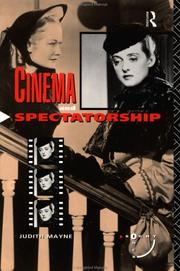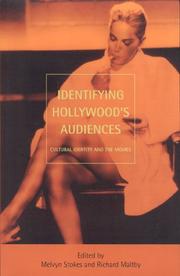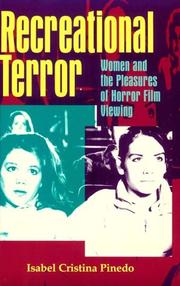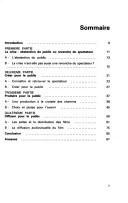| Listing 1 - 10 of 70 | << page >> |
Sort by
|
Book
ISBN: 303082120X 3030821196 Year: 2021 Publisher: Cham, Switzerland : Springer,
Abstract | Keywords | Export | Availability | Bookmark
 Loading...
Loading...Choose an application
- Reference Manager
- EndNote
- RefWorks (Direct export to RefWorks)
Motion picture audiences --- History. --- Film audiences --- Filmgoers --- Moviegoers --- Moving-picture audiences --- Performing arts --- Audiences

ISBN: 1134966881 128032824X 0203133889 9780203133880 0415034167 9780415034166 9780415034159 0415034159 9786610328246 6610328242 0415034159 9781134966882 9781134966837 1134966830 9781134966875 1134966873 9781138136441 1138136441 Year: 1993 Publisher: London New York Routledge
Abstract | Keywords | Export | Availability | Bookmark
 Loading...
Loading...Choose an application
- Reference Manager
- EndNote
- RefWorks (Direct export to RefWorks)
Cinema and Spectatorship is the first book to focus entirely on the history and role of the spectator in contemporary film studies. While 1970's film theory insisted on a distinction between the cinematic subject and film-goers, Judith Mayne suggests that a very real friction between ""subjects"" and ""viewers"" is in fact central to the study of spectatorship. In the book's first section Mayne examines three theoretical models of spectatorship: the perceptual, the institutional and the historical, while the second section focuses on case studies which crystallize many of the issue
Motion picture audiences. --- Film audiences --- Filmgoers --- Moviegoers --- Moving-picture audiences --- Performing arts --- Audiences --- StageScripts. --- Stage scripts --- ff StageScripts
Book
ISBN: 1474414966 1474414974 9781474414968 9781474414975 9781474414951 1474414958 Year: 2022 Publisher: Edinburgh
Abstract | Keywords | Export | Availability | Bookmark
 Loading...
Loading...Choose an application
- Reference Manager
- EndNote
- RefWorks (Direct export to RefWorks)
Is the experience of watching a film with others in a cinema crucially different from watching a film alone? Does laughing together amplify our enjoyment, and when watching a film in communal rapt attention, does this intensify the whole experience? Attending a film in a cinema implies being influenced by other people, an 'audience effect' that is particularly noticeable once affective responses like laughter, weeping, embarrassment, guilt, or anger play a role. In this innovative book, Julian Hanich explores the subjectively lived experience of watching films together, to discover a fuller understanding of cinema as an art form and a social institution that matters to millions of people worldwide. Combining recent scholarly interest in viewers' emotions and affects with insights from the blossoming debate about collective emotions in philosophy and social psychology, this study makes viewers more aware of their own experience in the cinema, and simultaneously opens up a new line of research for film studies.
Motion picture audiences. --- Motion picture audiences --- Film audiences --- Filmgoers --- Moviegoers --- Moving-picture audiences --- Performing arts --- Psychology. --- Social aspects. --- Audiences

ISBN: 0851707386 0851707394 Year: 1999 Publisher: London BFI Pub.
Abstract | Keywords | Export | Availability | Bookmark
 Loading...
Loading...Choose an application
- Reference Manager
- EndNote
- RefWorks (Direct export to RefWorks)
Philosophical anthropology --- Film --- Sociology of culture --- CDL --- 791.41 --- Motion picture audiences --- Motion pictures --- Film audiences --- Filmgoers --- Moviegoers --- Moving-picture audiences --- Performing arts --- Social aspects --- Audiences
Book
ISBN: 2757421476 2757401548 Year: 2019 Publisher: Villeneuve d'Ascq : Presses universitaires du Septentrion,
Abstract | Keywords | Export | Availability | Bookmark
 Loading...
Loading...Choose an application
- Reference Manager
- EndNote
- RefWorks (Direct export to RefWorks)
L’attention des observateurs occidentaux est aujourd’hui rivée sur l’Asie, au point que beaucoup se demandent si le centre économique mondial n’est pas en train de se déplacer de l’Atlantique vers l’océan Indien. L’essor de l’Inde lui confère une plus grande crédibilité culturelle sur la scène internationale et permet d’aborder le cinéma populaire indien d’un œil neuf. Dans le contexte actuel d’une mondialisation accrue des industries culturelles, la résistance de Bollywood aux productions hollywoodiennes sur son marché intérieur et sa présence hors de ses frontières font exception. Identifier les forces acquises à travers les décennies, les bouleversements en cours et les défis majeurs à relever, donne les clés d’une compréhension en profondeur du cinéma indien. L’analyse transversale des différentes étapes du processus de création cinématographique - de la production, distribution et exploitation des films, en passant par les industries techniques et la réception par les publics, jusqu’aux formes et contenus d’une filmographie représentative des deux dernières décennies - dévoile tous les enjeux, mais aussi les limites, de cette confrontation du cinéma populaire indien au modèle d’Hollywood et des grands groupes multimédias. Soucieux des enjeux contemporains, cet ouvrage propose pour la première fois d’aborder Bollywood sous l’angle des industries culturelles. L’approche de terrain nous plonge au cœur d’un système unique, à la fois foisonnant et rentable, divertissant et innovant.
Motion pictures --- Motion picture industry --- Motion picture audiences --- Film audiences --- Filmgoers --- Moviegoers --- Moving-picture audiences --- Performing arts --- Audiences --- mondialisation --- cinéma --- Bollywood
Book
ISBN: 0253006589 1283979489 9780253006585 9781283979481 9780253006486 0253006481 9780253006523 025300652X Year: 2013 Publisher: Bloomington
Abstract | Keywords | Export | Availability | Bookmark
 Loading...
Loading...Choose an application
- Reference Manager
- EndNote
- RefWorks (Direct export to RefWorks)
Beginning in the 1950's, ""Euro Horror"" movies materialized in astonishing numbers from Italy, Spain, and France and popped up in the US at rural drive-ins and urban grindhouse theaters such as those that once dotted New York's Times Square. Gorier, sexier, and stranger than most American horror films of the time, they were embraced by hardcore fans and denounced by critics as the worst kind of cinematic trash. In this volume, Olney explores some of the most popular genres of Euro Horror cinema-including giallo films, named for the yellow covers of Italian pulp fiction, the S&M horror film,
Motion picture audiences --- Horror films --- Film audiences --- Filmgoers --- Moviegoers --- Moving-picture audiences --- Performing arts --- Spookfests (Motion pictures) --- Motion pictures --- Haunted house films --- Monster films --- History and criticism. --- Audiences

ISBN: 0585055297 9780585055299 0791434419 0791434427 Year: 1997 Publisher: Albany, N.Y. : State University of New York Press,
Abstract | Keywords | Export | Availability | Bookmark
 Loading...
Loading...Choose an application
- Reference Manager
- EndNote
- RefWorks (Direct export to RefWorks)
In Recreational Terror, Isabel Cristina Pinedo analyzes how the contemporary horror film produces recreational terror as a pleasurable encounter with violence and danger for female spectators. She challenges the conventional wisdom that violent horror films can only degrade women and incite violence, and contends instead that the contemporary horror film speaks to the cultural need to express rage and terror in the midst of social upheaval.
Horror films --- Motion picture audiences. --- Motion pictures and women. --- Film audiences --- Filmgoers --- Moviegoers --- Moving-picture audiences --- Performing arts --- Women and motion pictures --- Women --- History and criticism. --- Audiences
Book
ISBN: 9783770557073 3770557077 3846757071 9783846757079 Year: 2014 Publisher: Paderborn : Wilhelm Fink,
Abstract | Keywords | Export | Availability | Bookmark
 Loading...
Loading...Choose an application
- Reference Manager
- EndNote
- RefWorks (Direct export to RefWorks)
»Gibt es das? Kann es das überhaupt geben? Einen erstklassigen Roman in moderner Zeit, der vom Gutsein handelt und obendrein gut ausgeht, der dabei von keinem Zuckerwölkchen Kitsch überstäubt ist?« In ihrer Kölner Poetikvorlesung versammelt Sibylle Lewitscharoff Gedanken zu Helden und Autos, Filmen und Wundern, der Schönheit von fiktiven Tieren und dem »Bunker des Realen«. Die Vorlesung kreist um zwei Leitfragen: Im Mittelpunkt steht einerseits die Anziehungskraft von Walker Percys Romanfigur Jack Bickerson Bolling; andererseits geht es um die Frage nach Wundern in der Literatur. Die in diesem Band erstmals publizierte Vorlesung hielt die Autorin aus Anlass ihrer Ernennung zur Literatorin 2012. Sie wird flankiert von Diskussionen, die Lewitscharoff mit Juri Andruchowytsch und Martin Mosebach und zwei ihrer ÜbersetzerInnen führte, sowie einer Laudatio Günter Blambergers.
Percy, Walker, --- Lewitscharoff, Sibylle, --- Motion picture audiences. --- Film audiences --- Filmgoers --- Moviegoers --- Moving-picture audiences --- Performing arts --- Audiences --- Levitscharoff, Sibylle, --- Levicharov, Sibile,
Book
ISBN: 904851505X 9089643621 9789089643629 9789048515059 9048518466 9789048518463 Year: 2012 Publisher: Amsterdam Amsterdam University Press
Abstract | Keywords | Export | Availability | Bookmark
 Loading...
Loading...Choose an application
- Reference Manager
- EndNote
- RefWorks (Direct export to RefWorks)
Moving away from the recent prevalence of text-based analysis in the field of film studies, 'Audience' tackles one of the most important issues in cinema - how the audience engages with film. Ian Christie has assembled contributions from many of the major figures in media studies, including Gregory Waller, John Sedgwick, and Martin Baker, in order to provide a wide-ranging survey of viewers' relationships with the screen. 'Audiences' utilizes psychoanalysis and psychology, which dominated early academic examinations of film, to parse and explain modern film-viewing habits. This wide-ranging volume also takes advantage of new technology to gain access to important data on audiences, from traditional box office studies to information on digital access to movies in the home. With a particular interest in individual consumers and their motivations, this timely collection spans the spectrum of contemporary audience studies. As the film experience fragments across multiple formats, 'Audiences' studies a broad range of viewers, and is essential reading for scholars and lovers of cinema.
Motion picture audiences. --- Film audiences --- Filmgoers --- Moviegoers --- Moving-picture audiences --- Performing arts --- Audiences --- Audience reception. --- Film --- Motion pictures --- Psychology and the cinema. --- Psykologi och film. --- Publik. --- Psykologiska aspekter. --- Psychological aspects.

ISBN: 2110019468 Year: 1988 Publisher: Paris Documentation française
Abstract | Keywords | Export | Availability | Bookmark
 Loading...
Loading...Choose an application
- Reference Manager
- EndNote
- RefWorks (Direct export to RefWorks)
Motion picture audiences --- -778.5 <44> --- 791.4 <44> --- Film audiences --- Filmgoers --- Moviegoers --- Moving-picture audiences --- Performing arts --- Audiences --- 778.5 <44> --- AVENIR ET LE CINEMA --- CINEMA --- SALLES DE CINEMA --- FRANCE
| Listing 1 - 10 of 70 | << page >> |
Sort by
|

 Search
Search Feedback
Feedback About UniCat
About UniCat  Help
Help News
News